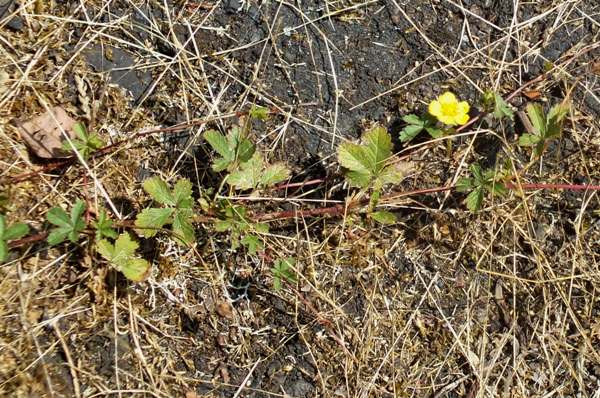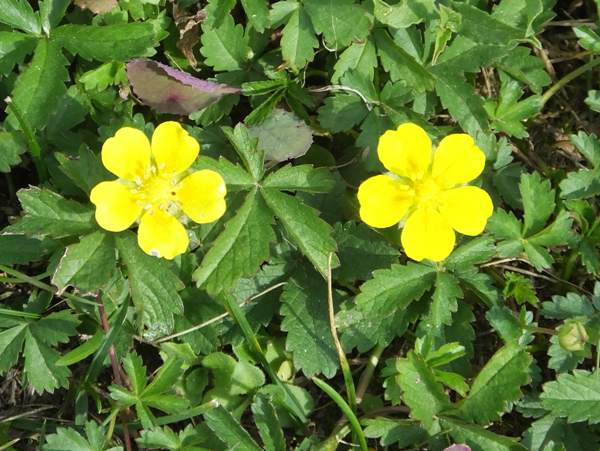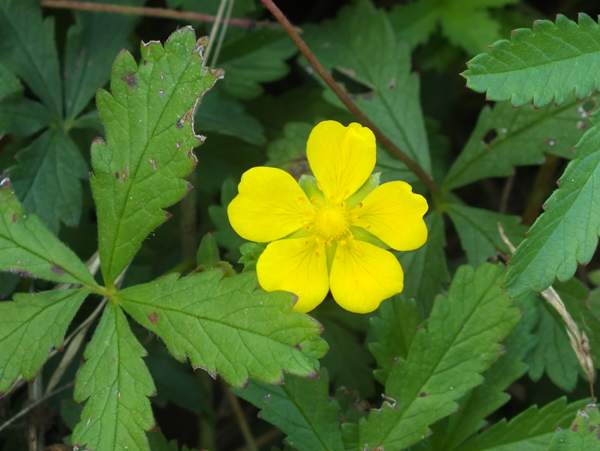Trees Birds Mammals Fish Amphibians Reptiles
Wild Algarve
Bookshop
Potentilla reptans - Creeping Cinquefoil
Phylum: Magnoliophyta - Class: Equisetopsida - Order: Rosales - Family: Rosaceae

Creeping Cinquefoil is one of several similar wildflower species found in Britain and Ireland.
Description
A perennial plant with limp stems reaching a height of just 10 to 15cm, Creeping Cinquefoil spreads via long rooting runners. Flowers 12 to 25mm across have five yellow notched petals surrounding 20 stamens and numerous pistils. The petals are backed by a much smaller five-lobed calyx. Stalked flowers are borne solitarily in leaf axils.

Spaced a alternately along the stems and varying from long-stalked to almost stalkless, the palmate leaves are divided into five (occasionally seven) toothed leaflets.
Distribution
Except for the far north of Scotland, Creeping Cinquefoil is fairly common and widespread throughout Britain and Ireland. This wildflower occurs also on mainland Europe, Asia and northern Africa, and it is a naturalised alien introduction in many parts of North America.

Habitat
This low-growing wildflower is often found on cliff tops, on urban wasteland, beside car parks and roadside laybys, and on upland hill slopes where the grass is short and the soil free draining. Creeping Cinquefoil spreadsmainly by means of runners that root readily on disturbed ground.
Blooming Times
In Britain and Ireland Creeping Cinquefoil blooms from June through to September.
Uses
In the past Creeping Cinquefoil was collected for the tannic acid in its rootstock; this was used in herbal medicines to treat various ailments and to disinfect wounds. (We strongly advise against eating or using as medicines any plants without first obtaining qualified professional advice.)
Etymology
Potentilla, the genus name, means 'powerful, despite its small size' and is a reference to the claimed medicinal value of plants in this genus.
The specific epithet reptans means creeping or crawling (in this instance, at least, not necessarily at the speed of a reptile!).
Similar Species
Tormentil, often found on cliff tops as well as in hedgerows, is similar but has four petals, while the five-petalled flowers of Silverweed might possibly cause confusion with Creeping Cinquefoil. Silverweed is easily distinguished by its leaves, which have many more pairs of leaflets and are silvery, at least on the underside and often on top as well.
The Creeping Cinquefoil plants shown on this page were photographed in West Wales during June and in northern France during September.
Sue Parker's latest ebook is a revised and enlarged edition of Wild Orchids in The Burren. Full details here...
Buy it for just £5.95 on Amazon...
Sue Parker's new ebook is a comprehensive and fully revised edition of her acclaimed field guide to the Wild Orchids of Wales. Full details here...
Buy it for just £5.95 on Amazon...
Please Help Us: If you have found this information interesting and useful, please consider helping to keep First Nature online by making a small donation towards the web hosting and internet costs.
Any donations over and above the essential running costs will help support the conservation work of Plantlife, the Rivers Trust and charitable botanic gardens - as do author royalties and publisher proceeds from books by Pat and Sue.